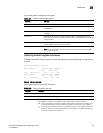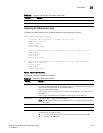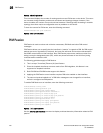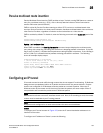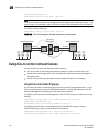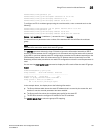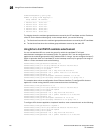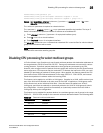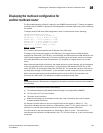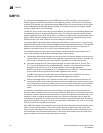
PowerConnect B-Series FCX Configuration Guide 763
53-1002266-01
Passive multicast route insertion
25
Passive multicast route insertion
Passive Multicast Route Insertion (PMRI) enables a Layer 3 switch running PIM Sparse to create an
entry for a multicast route (e.g., (S,G)), with no directly attached clients or when connected to
another PIM router (transit network).
PMRI is critical for Service Providers wanting to deliver IP-TV services or multicast-based video
services. Service Providers, who have transit networks, distribute multicast-based video services to
other Service Providers, regardless of whether a client subscribes to a video service.
PMRI is enabled by default. To disable it, enter the following command at the router pim level of the
CLI.
PowerConnect(config)#router pim
PowerConnect#(config-pim-router)#no hardware-drop
Syntax: [no] hardware-drop
When PMRI is enabled, the show ip pim mcache command output displays the multicast cache
entry along with a drop flag, indicating that the device is dropping packets in hardware. If the HW
flag is set to 1 (HW=1), it implies that the packets are being dropped in hardware. If the HW flag is
set to 0, (HW=0), it indicates that the packets are being processed in software. The following
shows an example display output.
Configuring an IP tunnel
IP tunnels are used to send traffic through routers that do not support IP multicasting. IP Multicast
datagrams are encapsulated within an IP packet and then sent to the remote address. Routers
that are not configured for IP Multicast route the packet as a normal IP packet. When the IP
Multicast router at the remote end of the tunnel receives the packet, the router strips off the IP
encapsulation and forwards the packet as an IP Multicast packet.
NOTE
An IP tunnel must have a remote IP interface at each end. Also, for IP tunneling to work, the remote
routers must be reachable by an IP routing protocol.
NOTE
Multiple tunnels configured on a router cannot share the same remote address.
Example
To configure an IP tunnel as seen in Figure 123, enter the IP tunnel destination address on an
interface of the router.
To configure an IP address on Router A, enter the following.
PowerConnect#show ip pim mcache
1 (10.10.10.18 226.0.1.56) in v10 (e1), cnt=2
Source is directly connected
Sparse Mode, RPT=0 SPT=1 REG=1 MSDP Adv=0 MSDP Create=0
fast=0 slow=0 pru=1 graft age drop
age=0s up-time=2m HW=1 L2-vidx=8191





